Social Volition
by Cora Cohen
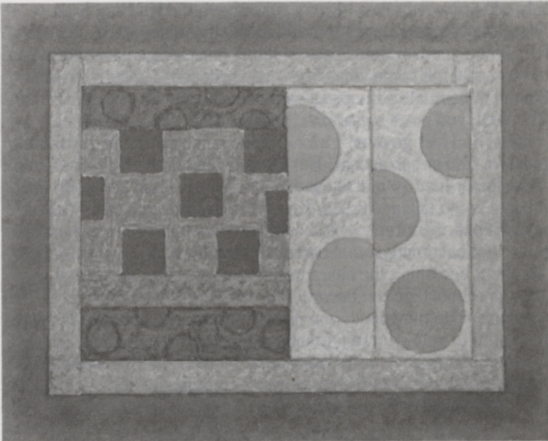
Ralph Humphrey, Great Jones , 1989. Casein on canvas, wood, 42 × 52". Courtesy Mary Boone Gallery.
Ralph Humphrey asked me about ten times what I thought of his last show. I said something different each time he asked. My characterization of the paintings as Protestant Philip Gustons amused him the most. I think I was referring, in a short-hand fashion, to a combination of the blunt and poetic in the same painting which Guston and Humphrey’s work share. The Protestant relates to the plain American, almost Hopperesque mise-en-scène situation. But rather than the sense of something which has already happened, as in the Guston KKK paintings, or the sense that something may occur, as in Hopper, Humphrey’s paintings themselves are virtual.
I met Ralph Humphrey when I was 19, and I knew him until his death in 1990. From the beginning, Ralph’s work was individualistic. It did not adhere to the reigning dogmas but reflected his particular way of seeing. It withstood separately at a time (the late ‘60s, early ’70s—Minimalism, Greenbergian formalism) when the pressure to forge a consensus exerted enormous power in the art world. His paintings, often outward-projecting and object-like, operated in a complex way—the more they shared (invaded) the viewer’s space, the greater was the role of their illusionism. Ralph’s art never eliminated the tentative, emotive or idiosyncratic. He followed his own natural poieses: he felt his way through. The paintings in his show in March 1990 were his last completed works. The shapes in the paintings, painted, cut and pasted on have personas, are individual, have constrained poignancy. Often in the isolation of each shape a restive bleakness is apparent.
These shapes are not figural to me yet I identify with them. Apprehending them and their fugitive movements enables me to sense my connection to a living organism which is not I, to that part of the world and perhaps even the universe which is isolated yet related to the rest, as I am. All the paintings but one from this show take their titles from SRO (Single Room Occupancy) hotels on the upper west side where Ralph had lived in the 1960s and are also, except for that one, the same titles he used for a group of his paintings in the ’60s. Great Jones , after Bill Jones, is the exception. Those hotels had long been demolished by the time Ralph titled his paintings for his 1990 show. Bill Jones was dead. What is left of one’s past when it’s physically gone? Had all those people who had lived on the edge (of society) disappeared? Is shelter impossible? Was the significance of these transient shelters dual in that they performed a temporary task and then disappeared?
I think the paintings are about the transience of the physical world, even when it is their own substance: their object-like quality diminishes as one looks at them. More than most paintings they change as one looks at them. What had appeared as visually static and absorbent begins to oscillate; a pulsating flicker caused by a slight chromatic transposition occurs where the shapes meet the ground. As the dynamic aspect of the painting affects one’s perception, the shapes seem to dissolve. In a constant alternating interplay, seeming certainty is relinquished by the most concrete elements as the rest becomes activated, the paintings take on depth. Through color—glowing color, saturated yet crepuscular color—these paintings assert their vitality.
Through color the paintings operate simultaneously as illusionistic and inverse illusion, moving towards the viewer and returning to their own boundaries. As followed by our gaze, color acts as the amplification of our motor being. During the long gaze the material nature of these acutely scaled paintings fades almost completely as the penumbral color activates a response to depth and its limits. Not to that of the space around one but to the limits of depth within oneself through one’s body. From the painting to the eye we know it must be but it feels like it touches the inside of the body first.
When Ralph died I became conscious of everything I might have asked him and hadn’t. I had taken for granted that the ideas behind the work of the people I knew would reveal themselves over time, without my directly inquiring; there is no substitute for an understanding gained during the course of seeing work and the subsequent spontaneous attenuated exchanges which have no purpose outside of themselves. But after Ralph’s death it began to seem possible that the thoughts of the artists I knew, what those artists regarded as their motivating forces, might remain unknown to me if I didn’t ask about them specifically even though direct examination risks changing the thing examined. I am now more inclined toward the notion that an artist’s verbal communication may bring the outsider closer to the meaning of that artist’s work. Connected to this is my belief (which forms the basis for some of my questioning) that how people live—their politics, how they have accepted or rejected their own backgrounds—has an effect on the art they make. My natural inclination is toward apprehending work sensually; toward art which is optically complex; toward art which is generous, inclusive, not worked over toward a signature style, towards artists who have more ideas than they know what to do with; towards vision, not the adjustments thereof; and an art which goes all over the place, sometimes literally.
I have resisted the Modernist authoritarian canon, which is essentially a stylistic approach requiring a compositional a priori, and its tacit insistence on oneness. I am interested in heterogeneity rather than formal unity; in allowing a painting distinctive and particular parts, permitting the varying operations of those differing parts to retain individual character and qualities. There isn’t a hierarchy within the painting. The mode of apprehension which follows is one in which the viewer puts the painting together herself. There is no agreed on “ideal” interpretation. Hierarchies in other areas have seemed equally misguided to me.
The artists I’ve questioned here are at different levels of development and exposure. During the past year and a half I have learned and borrowed from all of them. Although they communicate with varying degrees of fluidity, acuity, and success, all have a steadfast resistance to being cast into systems of speaking about their work, to jargon. All speak about their work in ways which are reflective of their work, using words as ways of communicating about what they believe they’ve made. The realm of ideas isn’t utilized as conspicuous display, nor are concepts advanced for the sake of invidious comparison.
Though these people were familiar to me, the underlying ideas behind their work and their motivating forces for making work were frequently surprising.
Dona Nelson
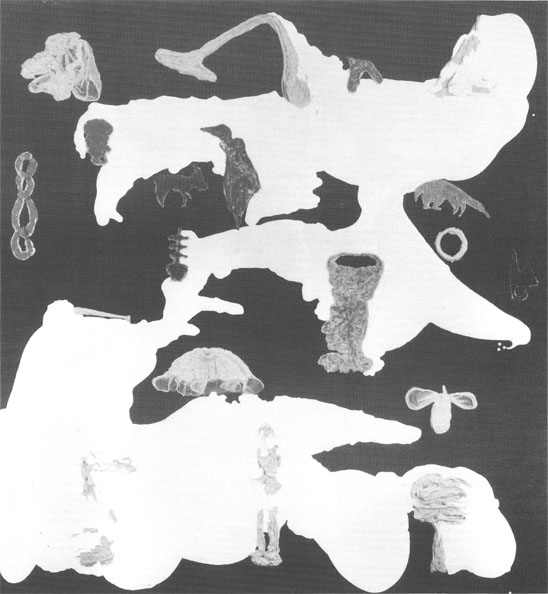
Dona Nelson, Full Sac, 1991. Fabric, canvas strips, string, acrylic, and china marker on canvas, 57 × 60".
Dona Nelson I work with materials till the image floats up to the surface; then the shape and materials are almost equal in their presence. I like it when the painting can’t contain the image—when the image busts out, when it is “too”: too big, too much of one color, etc. I’m not interested in depiction or representation but in the paintings which are about the feelings evoked by certain kinds of images, and the images are entwined in my mind with colors, shapes . . .
Cora Cohen We’ve often discussed the way we approach work. Do you think that has an effect on what your work looks like?
DN It’s a kind of bifocal quality—in which the materiality of the work parallels and sometimes overwhelms the image. In spending a lot of time around the studio without a “proper plan of action,” not having the idea before I make the work, and in using unpainted strips so I can’t see very well what I’m doing, there’s an imposed chaos.
CC How did your collage method of working get started, anyway?
DN In the early ’80s, I was dissatisfied with the work I was doing, but I liked certain things—a foot here, a face there. After a while, I realized that I wasn’t interested in the continuousness of realistic painting—that quality was about how paintings look but not about how the experience feels. I started cutting things up and putting different parts together. I am interested in what a painting is in relation to life—things like memory and the explosion—implosion of experience.
CC I didn’t know till today that you had begun as an “abstract painter.” What happened?
DN The subject matter paintings began in 1979 when I went back to school to become an art teacher because I had decided to drop out of the art world. I began to work with subject matter.
CC You mean, recognizably figural elements?
DN Yes. After experiencing the impact of subject matter in children’s and unprofessional artist’s work.
CC I guess you didn’t retire from the art world?
DN No. I’ve been in New York since I was young. I’m very busy with my painting, and I don’t really know where I fit in besides the art world—unfortunately, that’s the existing forum for painting.
CC Maybe you could say something about that.
DN The art world is compartmentalized. Most artists specialize. You have political artists in one gallery and abstract in another. They are very artificial kinds of separations. The formal is an aspect of the political. The world’s a mess and art is so tidy. People warn about aestheticizing content, and the art world itself is a completely aestheticized situation. By and large, most of the paintings that appear in the gallery situation are pre-digested finalities. You know, Peter Halley goes on making Peter Halleys and Roy Lichtenstein goes on making Roy Lichtensteins, etc. The ideas that generate these paintings are presented early in the artist’s career as justification and once these justifications are widely accepted, the artists more or less have their work cut out for them. The subsequent sequence of paintings is a very long parade rather than a dialogue. The whole idea of paintings as a finalized aesthetic statement rather then a mutable forum is arbitrary and deadly. There are a lot of possibilities for the play of subject matter with the making of paintings. All content, including political content, as it exists in the world, is process—full of ambiguities and cross currents.
Louise Fishman
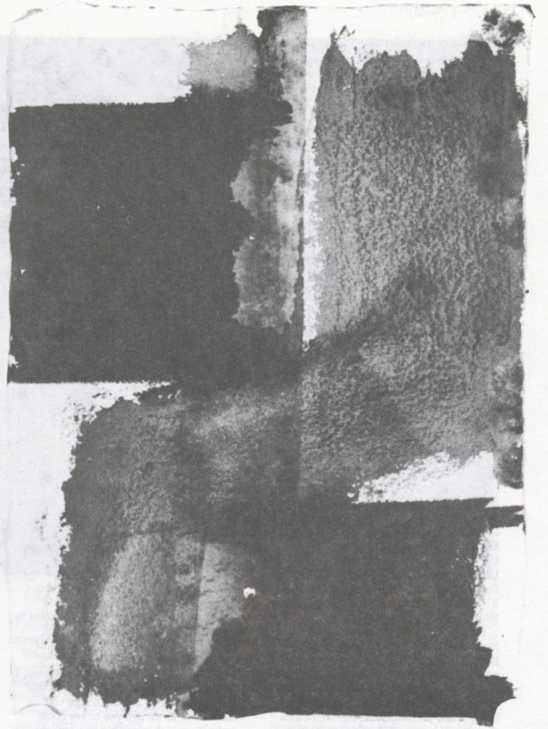
Louise Fishman, Untitled, 1990, watercolor on paper, 7 1/2 x 5 1/2". Photo by Betsy Cromwell. Courtesy of Lennon Weinberg Gallery.
Cora Cohen When you became public about the impact of your trip to the concentration camps of Eastern Europe (to the extent of letting us know that some of the paintings contain ashes from the Pond of Ashes from Birkenau) your relationship to the world was changed.
Have you ever thought of where your social responsibilities might lead you in relation to your work?
Louise Fishman I don’t plan these things in advance. My painting follows my life. It has seemed important to me to make choices about coming out as a woman, as a lesbian, and as a Jew—in my work—at times when these choices were politically powerful and important to those groups. It hasn’t helped my career. As long as I’m living in a society where people are ill and dying all around me, along with most artists, my work will reflect that reality. I just hope that my paintings aren’t going to be about illness and death much longer.
CC In your earlier work—paintings on paper or board, irregular, cut, seemingly forged together, I see and feel an involvement with substance as it’s encroached on by the environment, you being part of the environment. A call and response between the materials and the interposition of your will presents itself.
Would you describe the sources of your influences and the associations invoked in your work; do you see them predominantly as referring to culture or to the natural world?
LF The richest experiences I’ve had with art recently were with the Black Paintings of Goya, the Ecce Homo painting of Titian, and with early Brancusi sculpture. I would guess that the strongest source for my work is the natural world: rocks, air, space, water, trees, time, the physicality I experience with my own body, and the idea of mortality. But where would I be without the dialogue I have with Cézanne, Brancusi, and all the others?
CC Your new paintings utilize light that’s not within them; they absorb and refract light. To fully apprehend the painting the viewer must alter her position, and the painting seems yet again different. Thus the element of change rather than stasis prevails.
LF The light is deeper inside the paintings. It is equally true that the surface throws light around—at times confounding the viewer—in many cases the viewer feels a demand to move around to see the “other painting.” I did more moving around while making the paintings than anyone will have to do to “see them” because while they were still wet there was ten times the reflectiveness off each molecule of paint. It made me angry at times—the trouble seeing my own paintings, especially with the late afternoon light—when I had to stop painting altogether. So, in effect, the viewer may have a modified experience of the one I had making the paintings. I feel no remorse at bullying people in this way—I know what these paintings are capable of giving.
Carl Ostendarp
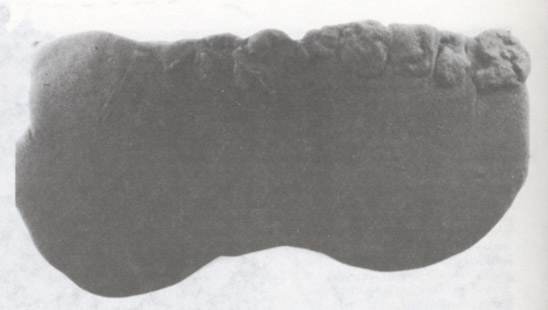
Carl Ostendarp, Still Farther South, 1990. Oil and insulation foam on linen 60 × 60". Courtesy John Post Lee Gallery.
Cora Cohen Do you feel that the materials and process you use determine the painting?
Carl Ostendarp No, but I pick ’em ’cause I want the paintings to be about gravity and weight, sort of obvious, literal kind of stuff. That’s why I use the materials I do. If the stuff you usually put on a surface is paint, then the foam is the paint, pretty much. I couldn’t get the clarity of the material and the all-at-once quality with whatever else I tried. I didn’t want it to look like it was about building it up really slowly.
CC Is there a blind part of working with the foam?
CO Yes, ’cause it’s about one-fifth or one-tenth of its volume when it’s in liquid form. There’s a catalyst and when you mix it together you have 30 or 40 seconds before it starts setting up and, like, growing. So I have to do everything really fast and depending on how I do it, like the big drippy paintings are poured on top of the thing and I let it drip down so if I put too much it’s on the floor and if I don’t…I’m not sure exactly how it’s going to look. I can make it look like a pancake, or I can make it look like a big drip, or I can find ways to make it look like a big brush stroke or something but it’s not like a drawn image. It’s a malleable thing. It becomes a thing as much as it becomes an image. Plus with this stuff, it grows. And it ends up giving the painting a weird terrain that looks self made, that doesn’t look determined, that doesn’t look like a picture.
CC There are parameters.
CO It’s more the format choices and how I’m going to deploy it that determines how it looks, or how much it looks, or what kind of changes happen. It’s like a goofy image, or a floating. You have to do them on the ground and put them up on the wall. Like those Pollock paintings done on the ground and then put up on the wall. All that stuff about abstract painting…like the Malevich paintings are outer space paintings, like this weird idea that the place to be is in outer space with nothing else around, and that’s what’s really great and abstract.
CC If you kept wanting the paintings to be about gravity and weight would you think about making that happen in another way, besides the foam?
CO I’ve got these drawings for paintings that aren’t on the wall the same way; they lean against the wall, and some are on the ground. And I could probably do these with just paint instead of foam. The work I’m interested in most is always work that’s about traditional painting but isn’t necessarily painting. It’s all that processy stuff, scattery stuff. Or sculpture that’s more about pictorial issues than form. Mostly it’s the look that’s really impressive. Like big blank looking things. And how they’re dumb and serious at the same time.
CC Your work is a funny combination, there’s austerity and sensuality. One wonders if there’s an emotional content to the whole thing. If there is and there probably is, what is it? Do you think of your art as psychological?
CO It’s more like a place than a picture. I like the idea of something frozen so that instead of looking at it as though you’ve made it, or as though you never could make it—which is one big way you get trained to look at art (you always get put in a certain place) I want it to look like: you know it’s art because since it’s painting it’s got this privileged quality to it; but your experience of looking is more noticing and responding to this real thing: what physically happened or what looks like is happening.
John Zinsser

John Zinsser, Fear of Black Butterflies, 1991. Oil on canvas, 60 × 84". Photo: Ken Showell. Courtesy Julian Pretto Gallery.
CC What about the content?
JZ I gave myself a vehicle I could work with for a number of years without any one painting being the single statement—that way I can have a velocity and freedom without having to overtly describe what it is in each painting. I want to have the literal matter of the painting also be the subject matter of the painting.
CC Aren’t the titles a bit cute: Hot Cockles, Spot the Winner?
JZ I see titles as a way for the viewer to get into the painting. I want a little bit of spin, something goofy. A lot of times the titles already exist in the popular culture realm; I hope abstract painting does not have to be excluded from that. I would enjoy titling no matter what endeavor I was involved in.
Saul Ostrow
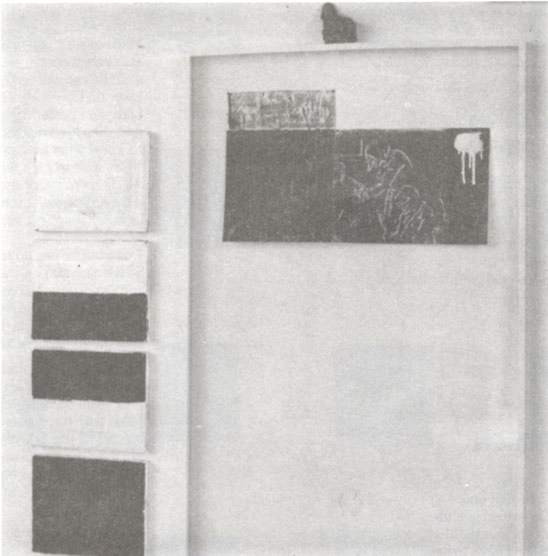
Saul Ostrow, Acts of Creation #6, 1987. Mixed media, 42 × 48", complete arrangement on wall.
Saul Ostrow A sculptor and painter, I never made the choice, I think about the body, even with the painting, I’ve hung things too low or too high, thinking about left-right splits in the body, a lot vertical vs. horizontal.
Cora Cohen In the Field of the Sight (1986), and In the Context of the Sight (1989) are related in title; are they situation of reversal?
SO Sight is the field of vision; the person looking at the painting is the site, looking out from this position; it’s why I put the red square at eye level. In the Field of the Site—muslin/wax/acrylic—is impenetrable; In the Context of the Sight—plexiglass—penetration.
CC What’s the color about in The Acts of Creation?
SO The color is from the Kabbalah. Each is a color of one of the Chakras: Black, white, silver, gold, primaries. It’s organized along the line of the separation of light from darkness. Color is symbolic, red = blood + just material. I’m interested in form, about how form is a content. How complete you can make it not about anything but about things. Things don’t have any meaning. I supply the parameters for interpretation—set up markers, a person can wander inside/outside never just any place, just inside the parameters. In The Symbolic Order the lead things are screwed down, not ordered, on a wood table, just fixed: armchair, vagina shape, hand, hand with gun, pointing hand, sphere with knife, TV; ever constant changing picture, frame, house, factory.
CC I find it poignant, tender, mundane; why, Saul?
SO Because it’s real, it’s never new, it’s never old, all of it are just sets of things.
CC In the Context of Exchange contains a beautiful stenciled armchair. What’s that for?
SO It’s Matisse—"Good art is like an armchair." Equivalences—an open-ended associativeness, it calls up notions of economics or economy. About what one exchanges for comfort—you pay something, there’s comfort; there’s an exchange.
CC What’s the title Reconstruction Under Duress about?
SO The painting is cut, split and reassembled; the title is from an essay by Adorno on Lukács where he criticizes Lukács who had been a Hegelian/idealist, then in the late 1930s became an apologist for Stalin (practical politics)—Adorno discusses that in Lukács is a resident voice which is always idealistic. So the painting has two halves of a whole, but each one also contains a whole painting, a whole voice. Each is emphatic, there is no in between.
CC In order for me to know your work I have to decode it. Things are symbols, titles refer to real world situations of politics and history; late work plays off earlier work. How we come to know your work, that we must work to know it, builds a connection. In experiencing your work the viewer becomes acutely aware of the importance of her role in causing the piece to be actualized. Is this aspect of your work one which you’ve sought to achieve? And does the fact that you have underproduced it have bearing here?
SO Yes. From the earliest, from the first work I was interested in: how do you get form and content to be at odds with each other? From Brecht whom I was interested in very early. Not just his politics but Brecht as a formalist. He could get these two things to co-exist and conflict with each other so they both become apparent with nothing invisible or taken for granted. Symbols and real world situations of titles; the split between site and sight; work is form and content; viewer is site + sight brings up the double aspect of each: sight = content, site = form.
Finish is equatable with resolution which is equatable with closure, which is equatable with certainty. Underproducing is a metaphorical state. Where one ends up putting the period ends up seeming arbitrary. It allows for a certain uncertainty on the part of the viewer and a (most interesting to me) certain amount of indifference. This state is what I take to be about what’s essential. What’s necessary is that the work be present but that it doesn’t scream for attention. This matter-of-factness, this directness puts what are the essentials of the piece into their clearest state.
CC Some might argue that the intertextual references of your work require a dialecticism which is extrinsic to the visual operation of your work. Do you agree?
SO I think any work—how any of us penetrate a work is—we penetrate with what we know (not of the work or the maker). For me a successful work of art gets penetrated over and over at different levels. One can see glyphs—monopoly, sign systems; then psychologically we see other things. I try to be complex. Setting parameters and possibilities and metaphorizing the gaze. I encourage the viewer to use their knowledge and not worry about if it’s there or not on my part, if they’re getting me or not. My job as an artist is to set up a situation in which the viewer finds their activities interesting. This leads into the idea of the unfinished, a lack of closure, each of these (things) (states) (interpretations) not being the definitive statement, unlike flash card art. What I like about my work is that it’s so easy to misread it.